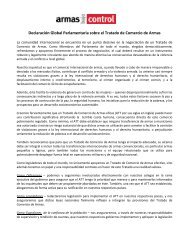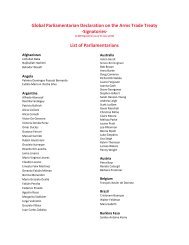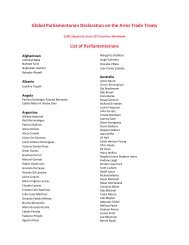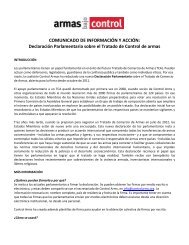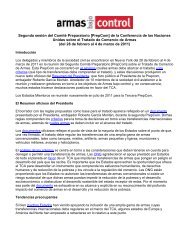Making it Work - Control Arms
Making it Work - Control Arms
Making it Work - Control Arms
- No tags were found...
Create successful ePaper yourself
Turn your PDF publications into a flip-book with our unique Google optimized e-Paper software.
24 MAKING IT WORK: MONITORING AND VERIFYING IMPLEMENTATION OF AN ARMS TRADE TREATYThe frequency and extent of such in-country review/verification activ<strong>it</strong>ies would be amatter for discussion and agreement by states parties and could be codified in thetreaty <strong>it</strong>self or as part of a protocol on mon<strong>it</strong>oring and inspections. For example, statescould be required to accept a certain number and type of inspections per year – e<strong>it</strong>herrandomly or at specified intervals – by an authorised inspection team.Finally, <strong>it</strong> is also conceivable that states parties may wish to agree verification proceduresthat could be invoked w<strong>it</strong>h a view to resolving specific instances of suspectednon-compliance. Provisions of this nature have been adopted – in the form ofchallenge inspections – by other international regimes, most notably under the CWC.Invariably, more pol<strong>it</strong>ically charged and difficult to manage, examples of their effectiveemployment are lim<strong>it</strong>ed. Nevertheless, this remains an option for consideration underan ATT.5.3Adjudication,disputesettlementprovisions andsanctions5.3.1 AdjudicationIt is possible that desp<strong>it</strong>e the invoking of consultation mechanisms and mon<strong>it</strong>oringand verification provisions under an ATT concerns may persist regarding compliancew<strong>it</strong>h Treaty obligations on the part of one or more states parties. Accordingly, theeffectiveness and credibil<strong>it</strong>y of the regime will be best served through the agreement offormal procedures for adjudication and dispute settlement along w<strong>it</strong>h recourse to theimpos<strong>it</strong>ion of sanctions in the event of a clear and established breach.It is important to clarify that there are at least three types of circumstances underwhich a breach of an ATT could occur – the first two of which could be considered‘technical’ and the third ‘substantive’. In the first instance, a state party could be consideredto be in breach of <strong>it</strong>s Treaty obligations if <strong>it</strong> fails to establish the requis<strong>it</strong>enational laws, regulations and administrative procedures that are required under anATT; where they are identified such breaches should be met w<strong>it</strong>h offers of appropriateassistance. Add<strong>it</strong>ionally, a state party that fails to fulfil <strong>it</strong>s reporting requirementsadequately and in a timely fashion could also be considered in breach; again suchoccurrences should be met w<strong>it</strong>h offers of support and assistance. Thirdly, and mostseriously, a state party could be considered in breach of <strong>it</strong>s treaty obligations by licensingan international arms transfer in contravention of the terms of the Treaty. Whiletransfers of this nature could conceivably take place as the result of a lack of capac<strong>it</strong>y,resources and/or expertise, the possibil<strong>it</strong>y of wilful neglect would also need to beconsidered. In this regard, the precise circumstances surrounding, and nature of, suchbreaches would need to be formally established, ideally by means of the mon<strong>it</strong>oringand verification provisions that are established under an ATT.W<strong>it</strong>h regard to a substantive breach, <strong>it</strong> is crucial to recognise that an ATT will differfrom other arms control and non-proliferation regimes in that proving that a particularinternational arms transfer has taken place will not necessarily be sufficient toestablish that a breach in compliance has taken place. This is because the adjudicationprocess will necessarily involve assessing a ‘suspect’ arms transfer against the objectivecr<strong>it</strong>eria that lie at the heart of the Treaty. Accordingly, the process of establishing that aviolation of the Treaty has taken place will necessarily involve two distinct components.In the first instance, a specified Treaty body (possibly an ATT Secretariat, an executiveinst<strong>it</strong>ution, or a Group of Experts appointed by a designated Treaty inst<strong>it</strong>ution) wouldneed to establish beyond doubt that a particular international arms transfer ofconcern has, in fact, taken place. As noted above, the mon<strong>it</strong>oring and verificationprovisions of the Treaty could be a cr<strong>it</strong>ical source of information in this respect. Once<strong>it</strong> were established that a ‘transfer of concern’ had taken place and the circumstancessurrounding the transfer had been clarified, <strong>it</strong> would need to be fully assessed by anappropriate Treaty inst<strong>it</strong>ution (for example a Meeting of States Parties) w<strong>it</strong>h a view to



